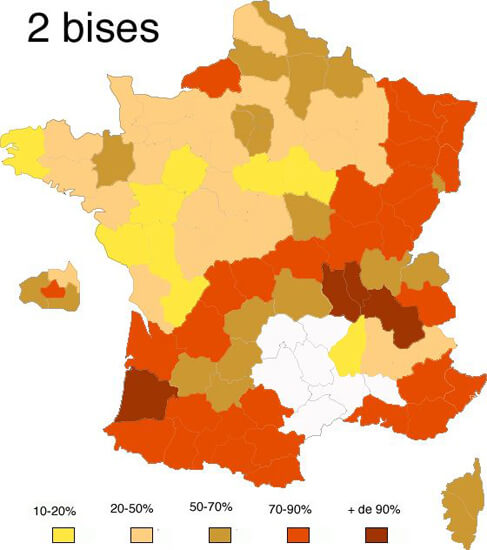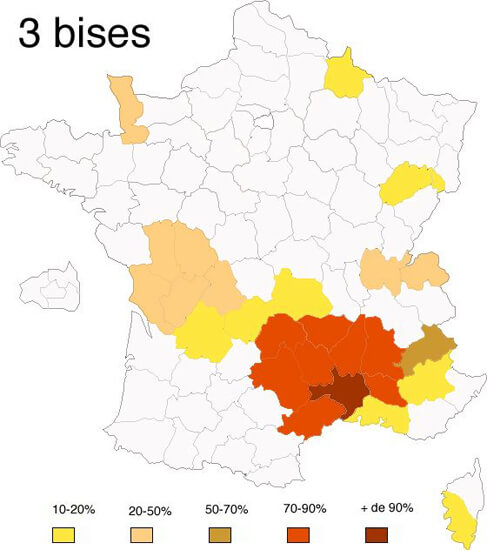Article written by Elisa - Travel Writer & Local in France
This article may contain compensated links. Please read disclaimer for more info.
Faire la bise – ‘to kiss on the cheek’ in France – is a tradition that, unfortunately, is not very welcome right now. Indeed, during these challenging times, the Minister of Health in France advises against practicing it.
In France, faire la bise is a greeting ritual used from Antiquity, even if the purpose or gesture may have slightly changed over the centuries.
How many kisses in France? Learn about the history of kissing in France, how to faire la bise (French greeting kiss on the cheek), and its variations depending on where you are in France.

Faire la Bise – History
We find the kiss in Roman times for different purposes. The Hebrews also exchanged kisses between members of the same family, before or after a long absence.
In the Middle Ages, the kiss was still used by people in greetings, but it was not compulsory, and sometimes it was replaced by an exchange of words or other gestures. Kissing in France was common when people united by bonds of affection had not seen each other for a long time or between members of the same family.
Also, in the Middle Ages, the lord and the vassal kissed each other on the mouth. This was the sign of a relationship of absolute loyalty.
The kiss on the mouth was also practiced in a religious setting. Called the ‘kiss of peace,’ this kiss on the mouth was only between men.
From the Renaissance, the kiss will gradually lose its official and sacred function, becoming a gesture of tenderness or affection.
Faire La Bise – When to Kiss in France
In France, we belong to a culture of contact. In other words, we need to ‘touch’ to express certain feelings.
The French greeting kiss is a tradition, an important gesture of greeting because it marks the opening and/or closing of a meeting.
La bise is also a gesture of affection. We don’t kiss just anyone; we kiss the people we love, the people we like.
Finally, faire la bise is also a sign of recognition and belonging to the same social group.
For example, in some French companies, people are used to kissing each other when they arrive at the office in the morning before heading to their desktop. In this case, it is a ritual act that signifies belonging to the same group. And it is an act that – believe it or not – we renew every day.
There are different ways of kissing in France: from a single kiss in the Finistère in Brittany to three kisses in Montpellier or the Massif Central, or even 4 kisses (!) in some departments around Paris.
In the end, each French region has its ‘kiss specificities’, good to know when traveling around France.
French Greeting Kiss (User Manual & Maps)
Data & Maps: JL Benoit-Guyod (personal work)
How to kiss in France? How many kisses in France? Here’s an overview of kissing in France (the French cheek kiss), followed by more detailed maps by the number of kisses. Please, take this information with a grain of salt: you can find different ways to kiss in a single department.
SPOILER: learning how to kiss in France is not an easy task!
Kissing in France Overview
How many kisses in France? Here’s a quick overview of the number of kisses by department:

How many kisses in France?
- 55% use 2 kisses
- 22% use 4 kisses
- 14% use 3 kisses
- 5% use 1 kiss
- 4% use 5 kisses
Faire la bise: where to start? Like many other things, it all depends on the region you come from. The vast majority of French people start their kisses with the right cheek then left. The followers of the left cheek, then right are found in the southwest, in Provence, Corsica, and Franche-Comté.
GOOD TO KNOW: the French kiss is everywhere the same in France!
Two Kisses in France
Faire la bise with two kisses on the cheek is predominant in the south of the line Bordeaux-Nancy.
The percentages shown on the legend for this map mean % of the population in a specific department that uses two kisses (one on each cheek).

Four Kisses in France

Four kisses still prevail north of the ligne Bordeaux-Nancy, especially in Aube and Yonne’s departments.
The percentages shown on the legend for this map mean % of the population in a specific department that uses four kisses.
Three Kisses in France

There’s a compact area that includes the departments of Ardèche, Cantal, Aveyron, Lozère, Hérault, Vaucluse, Drôme, Haute-Loire and Gard – essentially the eastern part of the Languedoc and Auvergne – where most of the people kiss three times.
The percentages shown on the legend for this map mean % of the population in a specific department that uses three kisses.
One Kiss in France

Only one kiss is rare to find in France except in Finistère (57%) and Deux-Sèvres (46%). These are the only two departments where this practice is dominant.
There is even an organization in Brittany which is fighting to maintain the bisou (one kiss) to say hello and not to give in to the ‘two-kisses Parisianism’.
The percentages shown on the legend for this map mean % of the population in a specific department that uses one kiss.
Five Kisses in France

Five kisses are even rarer in France, and you can see it mainly in Corsica with only 13% of the population in Haute-Corse) and 17% in Corse du Sud).
The percentages shown on the legend for this map mean % of the population in a specific department that uses five greeting kisses.
French Greeting Kiss – Recap (+ Hints)
As you can see above, there are strong regional disparities and you can find different ways to faire la bise in a single department.
The map here below gives a simplistic vision of how to kiss in France (the French greeting kiss on the cheek), but it’s definitely a map easier to remember:
Don’t stress too much! And – when kissing will be safe again – just look at what the others do and go with the flow.

French Word for Kiss
By now, you have learned the ‘faire la bise’ meaning. However, the French have more than one word for kiss, which can be confusing for French learners. While these words have similar meanings and use, they are not exactly the same:
UNE BISE. A kiss (or several kisses) on the cheek. It is mostly used in the expression ‘faire la bise‘ and is not romantic.
UN BISOU. It is also a kiss, but it is warmer and more familiar or playful. It can be either on the cheek or on the mouth (e.g., mother and child), but it is not romantic.
UN BAISER. It is a kiss on the mouth, usually between lovers.
UN BÉCOT (informal language). A quick kiss, peck.
UN PATIN (informal language). A French kiss, kiss with tongues.
UNE PELLE (informal language). A French kiss
The most common verbs used ‘to kiss’ are:
Donner un baiser
Faire une bise /un bisou
Embrasser

